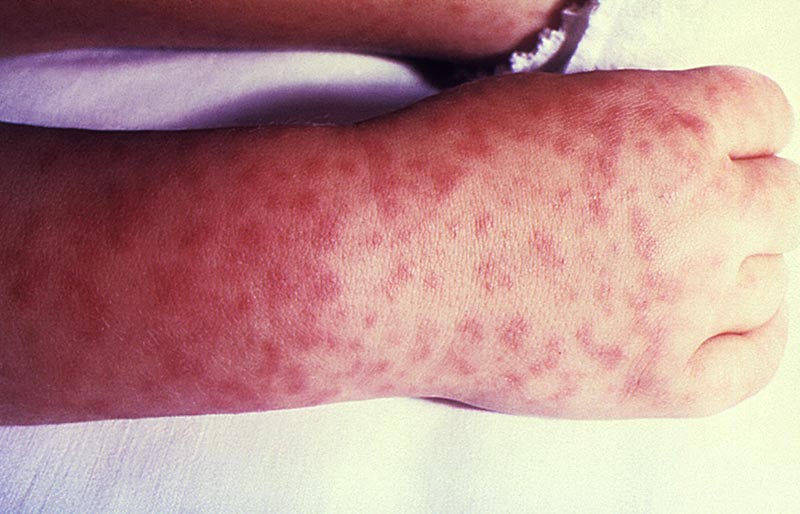Ticks and Tick-Borne Disease Prevention
Many Americans grew up in a time when ticks and tick bites were little more than unpleasant rites of passage on summer vacations and camping trips. But the rapid spread of tick-borne diseases in the United States has changed that perspective.
The Centers for Disease Control and Prevention (CDC) report that confirmed U.S. cases of tick-borne diseases more than doubled in the years between 2004 and 2016. Tick-related diseases now account for more than 75 percent of all diseases that can be transmitted by pests such as ticks, fleas, and mosquitoes. While Lyme disease is behind more than 80 percent of those cases, other tick-borne diseases are also increasing.1

Lyme infections often produce targetlike rashes around the bite site.
WHERE AND WHY TICK-BORNE DISEASES ARE SPREADING
The majority of US tick-borne illnesses happen in the eastern United States and along the Pacific coast, but disease-transmitting ticks exist in all the contiguous states — and their ranges are expanding.2 Since 1998, the ticks behind Lyme disease have increased their range by nearly 45 percent.3 Incidents of the disease have grown steadily as well. Now the country's most common disease caused by pests such as ticks or mosquitoes, Lyme is responsible for more than 300,000 illnesses annually.4
Gradual warming in many areas is one factor in the spread of tick-borne disease. As with disease-transmitting mosquitoes, areas that were too cold for some tick species are now moderate enough to sustain ticks through winter.
In some areas, cold-hardy ticks that once went dormant in winter now stay active year-round. The black-legged tick — a primary vector for Lyme and five other significant tick-borne diseases — is well-entrenched from north to south through the eastern half of the United States. Also known as the deer tick, it can bite and transmit disease anytime temperatures are above freezing.2
Exotic tick species bring new threats. In November 2017, officials in New Jersey identified an Asian tick, new to the United States. Already invasive through Australia and New Zealand, the Asian longhorned tick can transmit several animal and human diseases. In the months following its discovery, the tick species survived New Jersey's winter and showed up in several more states.5

Ticks transmit serious diseases to pets as well as humans.
WHAT SYMPTOMS TO WATCH FOR WHEN TICK BITES OCCUR
Symptoms of tick-borne diseases vary depending on the person and disease involved, but most people experience common symptoms including fever, chills, headache, fatigue, and muscle or joint pain. Temporary paralysis may strike as well.
With some tick-borne diseases, symptoms manifest quickly and clearly. Others take weeks to reveal themselves. Lyme infections typically result in large target-like rashes that appear up to 30 days after tick bites. The itchy spots associated with Rocky Mountain spotted fever generally appear within two to five days.6
Even when familiar symptoms don't result, don't take tick bites lightly. In July 2018, Wisconsin officials reported the state's first death from Rocky Mountain spotted fever.7 Between 2004 to 2016, seven tick-borne diseases were reported in U.S. states or territories for the very first time.1 The CDC anticipates these and other new forms of tick-borne disease will continue to present new threats.
With early treatment, antibiotics cure most tick-borne diseases, but diagnosis becomes more difficult over time. Early intervention reduces the risk of serious complications that can otherwise prove debilitating or fatal.

Rocky Mountain spotted fever causes a distinctive spotted rash.
HOW TO PROTECT AGAINST TICKS AND TICK-BORNE DISEASE
Even with changes in tick ranges, the most likely place you'll encounter ticks and tick bites is in your own yard. You can help protect your home and family with simple practices such as mowing your lawn frequently, keeping weeds and tall grasses cut down, and separating outdoor entertainment and play areas from natural areas bordering your lawn.
Effective treatment of lawn and ornamental garden spaces also helps control existing ticks and new ones that appear. Granular products such as Amdro Quick Kill Lawn Insect Killer Granules and Amdro Quick Kill Insect Killer for Home Perimeter protect full lawns and home perimeters, killing ticks by contact for up to three months. Amdro Quick Kill Insect Killer for Lawn & Landscape, available as Ready To Spray or Concentrate, kills ticks in lawn grass, gardens, shrubs and trees.
With Amdro products, you can protect your family, pets, and property from ticks and tick-borne disease. The folks behind the Amdro brand are committed to providing you with timely alerts and premium pest control products to help you reclaim your outdoor spaces from emerging pest threats.
Always read product labels thoroughly and follow instructions carefully.
Amdro and Amdro Quick Kill are registered trademarks of Central Garden & Pet Company.
Sources:
1. Centers for Disease Control and Prevention, "Vital Signs: Trends in Reported Vectorborne Disease Cases — United States and Territories, 2004–2016," May 4, 2018.
2. Centers for Disease Control and Prevention, "Geographic Distribution of Ticks that Bite Humans," August 22, 2018.
3. R.J. Eisen et al., "County-Scale Distribution of Ixodes Scapularis and Ixodes Pacificus (Acari: Ixodidae) in the Continental United States," Journal of Medical Entomology, January 18, 2016.
4. Centers for Disease Control and Prevention, "Why Is the CDC Concerned about Lyme Disease?," December 1, 2017.
5. U.S. Department of Agriculture, "Longhorned Tick: Information for Livestock and Pet Owners," August 2018.
6. Centers for Disease Control and Prevention, "Symptoms of Tickborne Illness," June 2015.
7. Wisconsin Department of Health, "DHS Confirms Death of a La Crosse County Resident from Rocky Mountain Spotted Fever," July 10, 2108.




